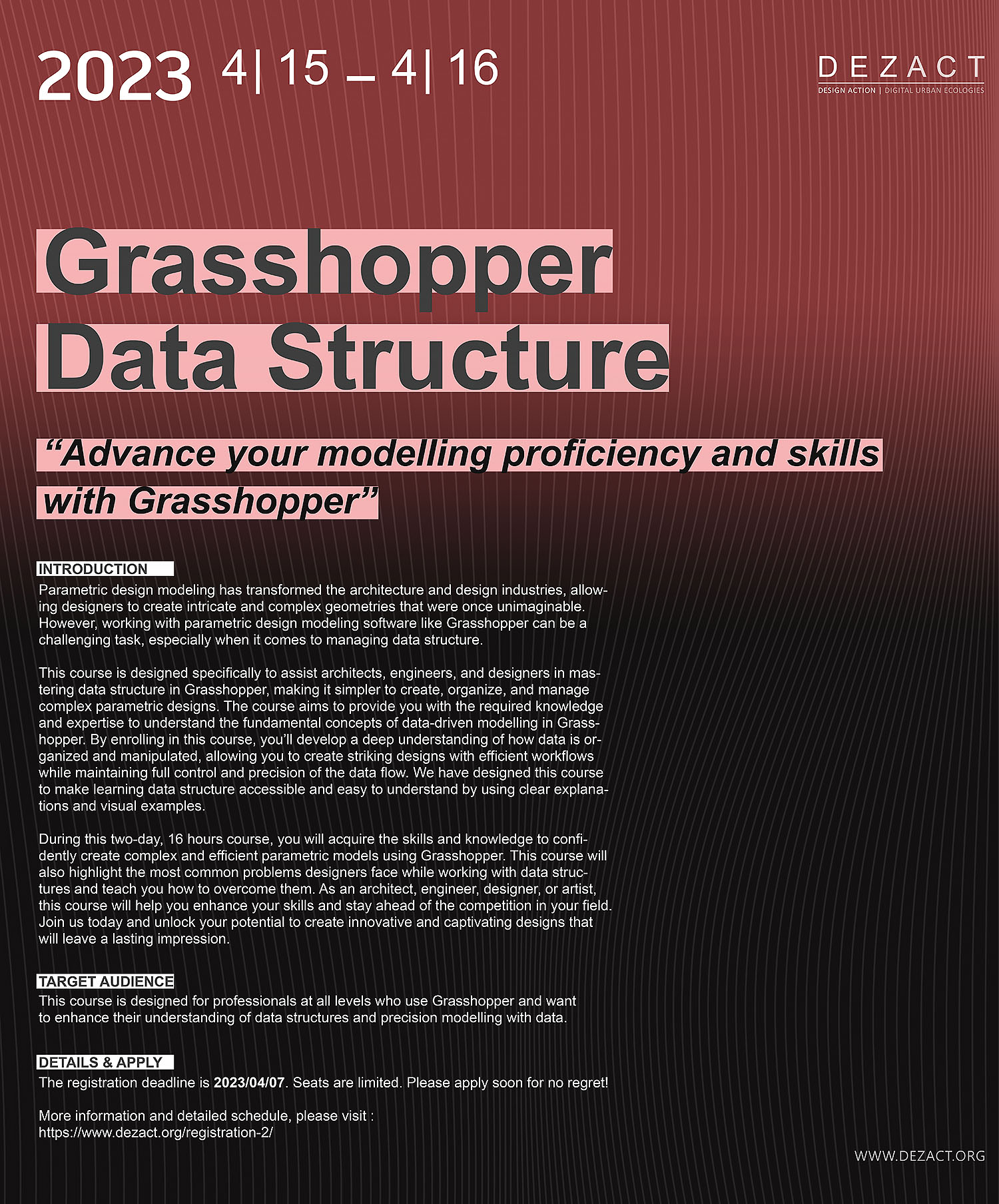
Date : 2023/04/15-16 (Sat/Sun) weekend
Time : 9:00-16:00 GMT
Course Format : online Zoom
Language : English
Target : This course is designed for professionals at all levels who use Grasshopper and want to enhance their understanding of data structures and precision modelling with data.
Software: Rhino 7.0 / Grasshopper /
Other Courses>>
Welcome to our Grasshopper Data Structure course!
Course Introduction
Parametric design modeling has transformed the architecture and design industries, allowing designers to create intricate and complex geometries that were once unimaginable. However, working with parametric design modeling software like Grasshopper can be a challenging task, especially when it comes to managing data structure. This course is designed specifically to assist architects, engineers, and designers in mastering data structure in Grasshopper, making it simpler to create, organize, and manage complex parametric designs. The course aims to provide you with the required knowledge and expertise to understand the fundamental concepts of data-driven modelling in Grasshopper. By enrolling in this course, you’ll develop a deep understanding of how data is organized and manipulated, allowing you to create striking designs with efficient workflows while maintaining full control and precision of the data flow. We have designed this course to make learning data structure accessible and easy to understand by using clear explanations and visual examples. During this two-day, 16 hours course, you will acquire the skills and knowledge to confidently create complex and efficient parametric models using Grasshopper. This course will also highlight the most common problems designers face while working with data structures and teach you how to overcome them. As an architect, engineer, designer, or artist, this course will help you enhance your skills and stay ahead of the competition in your field. Join us today and unlock your potential to create innovative and captivating designs that will leave a lasting impression.
Have you ever encountered the following situations?
Designers working with parametric design modeling software often struggle with data management. The complexity of Grasshopper can make simple tasks overwhelming and lead to errors, inefficiencies, and confusion. However, by taking this course, you’ll gain the skills and knowledge you need to manage your data with confidence. Whether you want to maintain control of your geometries, avoid Grasshopper crashes, or optimize your workflow, we’ve got you covered.
Join us and get answers to these common questions:
A. How can I maintain control of my geometries in parametric modelling?
B. How can I avoid Grasshopper crashes when dealing with complex scripts?
C. How can I prevent duplicating scripts and losing parametric relationships in my models?
D. Is there a way to approach data structure functions without guessing and wasting time?
E. How can I keep track of different data types and components in my Grasshopper definition?
F. How can I ensure correct data flow and avoid loss or duplication of information in my Grasshopper definition?
G. How can I ensure different models with different data structures can work together without disrupting the downstream modelling workflow?
H. What are the best practices for organizing and structuring data in Grasshopper?
I. How can I optimize my Grasshopper definition for efficiency and avoid slowing down my computer or workflow?
J. How can I debug and troubleshoot data flow issues in my Grasshopper definition?
Expectation of the course
As we understand that data structure can be a challenging topic to master, especially for those who are new to programming and the concept of computational geometry. During this two days course, our experienced trainer, Ping-Hsiang Chen will guide you through a comprehensive curriculum that covers all aspects of data structure, from basic concepts to advanced techniques. As a participant in this course, you’ll benefit from hands-on exercises and practical examples that will help you apply what you’ve learned to real-world design scenarios. You’ll also have access to our trainer who will answer your questions and provide personalized support throughout the course.
Upon completion of this course, you’ll have the skills and knowledge to confidently create more complex and efficient parametric models using Grasshopper. Whether you’re an architect, engineer, designer, or artist, this course will help you take your skills to the next level and stay ahead of the competition in your field.
Instructor Intro
Ping-Hsiang Chen is a highly skilled computational design expert with more than 10 years of experience. He is a UK registered architect and chartered member of RIBA, currently working as a Senior Architect at Zaha Hadid Architects. Previously, he held key positions at Applied Research Team in KPF and Mamou-Mani Architects, where he was responsible for providing geometric and architectural solutions. In addition, he is the founder of GrasshopperCourse.com, a leading consultancy that offers comprehensive software development and training services to top companies in various design disciplines including McNeel Europe.
04/15 – Morning
a. Data Driven Design
b. Numerical Control
c. Math and Expression
d. Geometry Manipulation
04/15 – Afternoon
a. Basic Data Structure
b. List Management
c. Conditional Modelling
d. Data Replacement
04/16 – Morning
a. Data Tree Introduction
b. Custom Domain
c. Data Grouping
d. Debugging
04/16 – Afternoon
a. Advanced Data Structure
b. Path Manipulation
c. Data Sorting and Classification
d. Index Mapping
